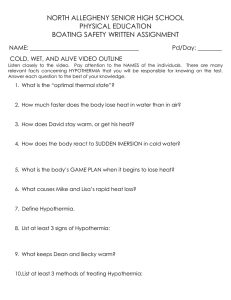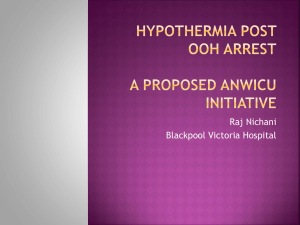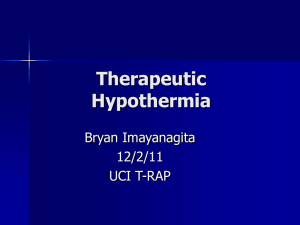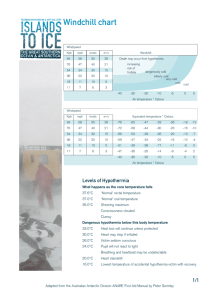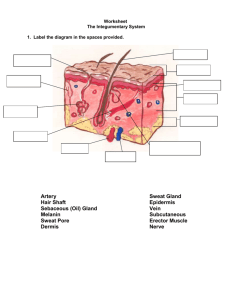Evidence-Based Practice Clinical Resources
advertisement
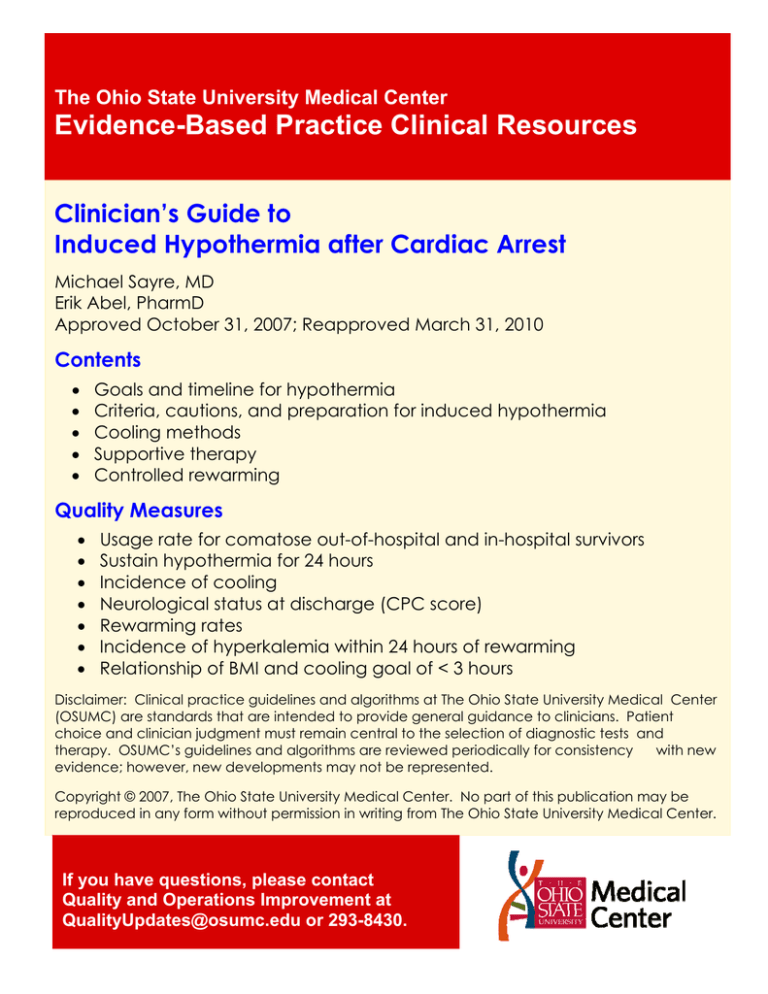
The Ohio State University Medical Center Evidence-Based Practice Clinical Resources Clinician’s Guide to Induced Hypothermia after Cardiac Arrest Michael Sayre, MD Erik Abel, PharmD Approved October 31, 2007; Reapproved March 31, 2010 Contents • • • • • Goals and timeline for hypothermia Criteria, cautions, and preparation for induced hypothermia Cooling methods Supportive therapy Controlled rewarming Quality Measures • • • • • • • Usage rate for comatose out-of-hospital and in-hospital survivors Sustain hypothermia for 24 hours Incidence of cooling Neurological status at discharge (CPC score) Rewarming rates Incidence of hyperkalemia within 24 hours of rewarming Relationship of BMI and cooling goal of < 3 hours Disclaimer: Clinical practice guidelines and algorithms at The Ohio State University Medical Center (OSUMC) are standards that are intended to provide general guidance to clinicians. Patient choice and clinician judgment must remain central to the selection of diagnostic tests and therapy. OSUMC’s guidelines and algorithms are reviewed periodically for consistency with new evidence; however, new developments may not be represented. Copyright © 2007, The Ohio State University Medical Center. No part of this publication may be reproduced in any form without permission in writing from The Ohio State University Medical Center. If you have questions, please contact Quality and Operations Improvement at QualityUpdates@osumc.edu or 293-8430. 1 Induced Hypothermia after Cardiac Arrest Rationale Use of hypothermia treatment in patients following cardiac arrest lessens the chance of ischemic brain damage and leads to improved neurological outcomes at 6 months. Ethical Considerations • Withdrawal of treatment. Allow a minimum of 72 hours from time of cardiac arrest before considering withdrawal of treatment. • Palliative Care / Ethics Consult. If rapid neurological recovery has not occurred after 72 hours from the time of cardiac arrest – and/or to assist patient’s family with treatment decisions – a Palliative Care or Ethics Consult is recommended. Criteria All of the following criteria must be met: • Cardiac arrest, with return of spontaneous circulation. o Evidence indicates that best neurological outcomes occur if initial rhythm at time of cardiac arrest was ventricular tachycardia or ventricular fibrillation and the event happened prior to hospital arrival. Initiation of therapeutic hypothermia for other types of patients may be considered, but effectiveness is not well established. • Hypothermia therapy to be undertaken as soon as possible, preferably within 6 hours of cardiac arrest. ○ If hypothermia not started within 6 hours, benefit is unknown. • Intubated with mechanical ventilation. • Coma at time of cooling (coma defined here as no purposeful movement to verbal command). • Brainstem reflexes and pathological posturing movements permissible. • Patients with Glasgow Coma Scale (GCS) of 3 are eligible. Goals • • • Initiate hypothermia within 6 hours of cardiac arrest. Sustain hypothermia for 24 hours from time of initiation of cooling to a body temp of 32-34° C (89.6-93.2° F). After 24 hours of cooling, rewarm slowly to achieve a normal body temp within 8 hours. (NOTE: If patient is rewarmed too quickly, the benefits of hypothermia are decreased.) Cautions Caution should be used for the following conditions: • Intracranial hemorrhage. • Major surgery within 14 days. • Systemic infection / sepsis. • Known bleeding diathesis or active ongoing bleeding. • Temp < 30° C (86° F) after cardiac arrest. Preparation • • • • • Begin treatment early. o Confirm eligibility and gather materials. o Start cooling as early as possible for maximum effectiveness. o Initiate therapy in the ED when possible. o Continue treatment in the cath lab or ICU. Place an arterial line for pressure monitoring. Do not delay cooling if unable to place line. Monitor temp to prevent “overcooling.” o Monitor temp continuously. Use a bladder temp probe (or an esophageal or pulmonary artery temp probe if patient not producing urine). o Document temp every 30 minutes during active cooling and rewarming, and every hour during maintenance phase. o Secondary temperature monitoring only if body temp < 30° C (86° F). Do not actively warm patients who are spontaneously hypothermic following cardiac arrest. Continue other therapies as indicated. 2 Induced Hypothermia: Cooling and Maintenance Goal: Sustain for 24 Hours Phase I: Cooling Phase II: Maintenance 3-hour (or less) Goal: Cooling to body temp of 32-34º C Blood Pressure • (89.6-93.2º F) Provide Continuous Sedation (See algorithm, page 3) Prevent Shivering (See algorithm, page 3) Give Cold Fluids • Give cold saline infusion via a peripheral line or femoral venous catheter to assist in achieving goal temp. (Cold saline is stored in the emergency department -- or call pharmacy.) o The infusion is 30 ml/kg of 4º C (39.2° F) normal saline over 30 minutes (2 L for a normal-size adult). o Do NOT give cold fluids if there is clinical evidence of CHF or CVP greater than 20. o DO NOT give cold fluid via a jugular or subclavian line. Arrhythmias • Provide External Cooling with Gaymar and Ice • Obtain two cooling blankets, cables, and one Gaymar machine to “sandwich” the patient. o On Gaymar controller, select MANUAL mode and adjust set point temp to 4º C (39.2º F) or the lowest temp for the system. o Pack patient in ice (groin, chest, axillae, side of neck) to bring temp between 32-34º C (89.693.2º F). Avoid packing ice on top of the chest, as this may impair chest-wall motion. o Once temp is < 34º C (93.2º F): Remove ice bags to prevent excessive drop in patient’s core temp. Switch the Gaymar controller into AUTO mode and the target temp to 33.5º C (92.3º F) • At time 0, obtain Chem 7 with Mg, troponin, CBC, PT/PTT, INR, blood gas. Accu-Chek q1h x4. (ICU glycemic target 110-140 mg/dl) Skin Care • Check skin every two hours for injury caused by ice or cold blankets. Nutrition • Do not provide enteral nutrition during the initiation, maintenance, or re-warming phases of therapy. Monitor patient for arrhythmia associated with hypothermia. If persistent, life-threatening dysrhythmias, hemodynamic instability, or bleeding develop, discontinue cooling, and ensure that the patient is actively re-warmed. o Heart rates < 40 are frequent and are not alone a cause for concern in the absence of other evidence of hemodynamic instability. Labs / Blood Gases • At hours 4, 8, 12, 16, 20, and 24, obtain glucose, K+, and blood gas. • Potassium Goal: 4.0 – 4.5 mEq/L Treat potassium values < 4.0 mEq/L with IV or nasogastric administration of K+ while the patient is being cooled. • Glucose should be kept at target range of 110-140 mg/dl and treated with insulin if elevated. (For IV Insulin Infusion guideline, refer to OneSource/Departments/Pharmacy/ Drug Guidelines & Protocols.) • Maintain PCO2 in the normal range (35-45 mm Hg). Labs / Blood Gases • To optimize cerebral perfusion, a mean arterial pressure (MAP) goal of 80-100 mm Hg is preferred. o If MAP < 80 mm Hg, norepinephrine may be used beginning at 0.1 mcg/kg/min to titrate MAP above 80 mm Hg. o Determine MAP goal by balancing the cardiac safety with the theoretical advantage of higher cerebral perfusion pressure. o Because of peripheral vasoconstriction, BP often remains elevated during hypothermia. o Hypotension (MAP < 80 mm Hg) from vasodilation is a concern during warming phase. Skin Care • Check skin every two hours for injury caused by ice or cold blankets. Nutrition • Do not provide enteral nutrition during the initiation, maintenance, or re-warming phases of therapy. Induced Hypothermia: Overcoming Natural Thermoregulatory Processes 3 Normal Process: Temperature < 37° C = arteriovenous vasoconstriction → Temperature ≤ 35.5° C = shivering response Induction of Hypothermia Initiate acetaminophen 650 mg PO/NG/PR Q6H CONSIDER Buspirone 15-30 mg PO / NG once Goal RASS -3 to -4 Initiate continuous IV sedative Propofol Midazolam Lorazepam If not at goal RASS, use sedation AND analgesia Initiate scheduled or continuous IV analgesia Fentanyl Hydromorphone NO intention to decrease sedation / analgesia after induction for ≥ 24 hr NO intention to be able to fully assess neurologic status until ≥ 48 hr after initiation of induced hypothermia Advisory Statements: Shivering typically SLOWS or STOPS at temperatures of 31-33° C Train of Four (TOF) is not reliable in patients undergoing induced hypothermia and should NOT be used to monitor/titrate neuromuscular blockers (NMBs) Pharmacodynamics / pharmacokinetics of most sedatives, narcotic analgesics, and NMBs are SIGNIFICANTLY affected during induced hypothermia Monitor for changes to temperature control and address by starting at previous steps in algorithm Advisory Statements: Close monitoring is required for early suspicion and detection of seizures There should be a low threshold to treat suspected seizures Meperidine is NOT advised due to the following: Hypothermia by definition decreases GFR Meperidine increases risk of inducing seizures in patients with low GFRs NO YES Shivering? Because of pharmacokinetic changes in induced hypothermia: Vecuronium is preferred for intermittent boluses (half-life is 2-3 X longer) Cisatracurium is preferred if a continuous infusion NMB is required ● Increase level of sedation (Goal RASS -4 to -5) ● Use single bolus vecuronium (0.1 mg/kg). Physician must be present for first dose per policy ● Apply warm cloths/blankets to hands, feet, and face CONSIDER ● Repeat Buspirone 15 -30 mg PO / NG once ● Use vecuronium bolus (0.05 to 0.1 mg/kg) Q4H prn shivering If shivering persists after > 3 boluses of vecuronium, initiate cisatracurium bolus 0.2 mg/kg bolus followed by continuous IV infusion of 0.5 to 1 mcg/kg/min Upon initiation of controlled re-warming phase (PHASE III), NMB use should be minimized / discontinued Sedatives/analgesics should NOT be decreased until 6-8 hrs after last dose of NMB and should NOT be discontinued until temp ≥ 35° C 4 Induced Hypothermia: Transition to Rewarming and Controlled Rewarming Goal: Sustain for 8 Hours Phase III: Transition to Rewarming and Controlled Rewarming 8-Hour Goal: Warming at about 0.3° C (0.5° F) per hour, up to a target of 36°C (96.8° F). Controlled Rewarming • Begin rewarming 24 hours after initiating cooling. • Rewarm at a rate of 0.3º C (0.5° F) every hour. • Most patients require about 8 hours to rewarm. • The goal after rewarming is normothermia. Medications During Rewarming • • Maintain sedation until a temp of 35° C (95° F) is reached. o If a neuromuscular blocking (NMB) agent is infusing solely to prevent shivering, discontinue the neuromuscular blocking agent before the sedative/analgesic agents. o Do not decrease sedatives/analgesics until 6-8 hrs after last dose of NMB and do not discontinue sedatives/analgesics until temp ≥ 35° C or until the patient is moving. Monitor patient for hypotension (secondary to vaso-dilatation) induced by rewarming. Labs • Discontinue potassium infusions. • At hours 28 and 32, obtain Chem 7. Rewarming with the Gaymar Device • Increase AUTO temp by 0.3°C (0.5° F) every 1 hour. • Remove the Gaymar and blankets after a stable temp of 36°C (96.8° F) for 1 hour has been reached. • Acetaminophen and external cooling prn to keep temp < 37.5° C (99.5° F) for 48 hours after admission. Order Set: DX HYPOTHERM-INDUCED. References • • • • 2005 American Heart Association Guidelines for Cardiopulmonary Resuscitation and Emergency Cardiovascular Care, Part 7.5: Postresuscitation Support. Circulation 2005; 112(suppl IV):IV-84 – IV-88. Bernard S. Therapeutic hypothermia after cardiac arrest: now a standard of care. Crit Care Med 2006;34:923-24. Hypothermia after Cardiac Arrest Study Group. Mild therapeutic hypothermia to improve the neurologic outcome after cardiac arrest. NEJM 2002; Feb 21;346(8):549-56. Nolan JP, Morley PT, Vanden Hoek TL, et al. Therapeutic hypothermia after cardiac arrest: an advisory statement by the Advanced Life Support Task Force of the International Liaison Committee on Resuscitation. Circulation 2003;108:118-121. Contact Information • • • Physicians: Michael Sayre, MD, or Michael Cudnik, MD Nurses: Marcia Belcher, RN; Sheila Chucta, RN; Brenda Vermillion, RN; or Todd Yamokoski, RN Pharmacist: Erik Abel, PharmD Appendix A Induced Hypothermia Flow Sheet 38 Phase I: Cooling Preparation for Transition Phase II: Maintenance Phase IV: Controlled Rewarming Attempt arterial line placement early Two to three hours prior to Phase III minimize potassium replacement and discontinue any neuromuscular blockade Normothermia 37 Temperature ( C) 36 35 Shivering response likely between 33.5 and 35°C 34 Target Temperature Range 32 – 34 °C 33 MAP Goal 80- 100 mmHg 32 31 Increasing physiologic abnormalities as temperature approaches 30° C. See Appendix B “Physiologic Effects of Mild to Moderate Hypothermia” 30 Corresponding Lab Draw Schedule 2 4 6 8 aPTT/PT/INR X ABG Accucheck X CBC X Chem 7 X Troponin Time/Date Initiated X 12 14 16 18 20 22 24 26 28 30 32 The following are the minimum labs that are to be drawn during Induced Hypothermia X X (if no insulin gtt) 10 Time (hr) Baseline X X X X X X X X X X X X X X X X X X X Time/Date first at <34°C Time/Date to begin transition 6 Appendix B Physiologic Effects of Mild to Moderate Hypothermia (30 - 34° C) Goal: Decrease the cerebral metabolic rate and oxygen requirements to suppress inflammatory cellular responses associated with reperfusion injury (free radical production, release of neuroexcitatory and inflammatory cytokines and calcium shifts) which mediate apoptosis. Table 1. Summary of Physiologic Effects of Induced Hypothermia Potential / Expected Effects Clinical Pearls Neurologic • Decreased consciousness, lethargy, coma Cardiovascular • Bradycardia • Vasoconstriction • Moderate to Severe arrhythmias o Atrial fibrillation/flutter o Ventricular tachycardia o Ventricular fibrillation • EKG changes: o Prolonged PR, QRS and QT intervals, Osborn waves • Decreased cardiac output → increased CVP Renal/Electrolytes • Increased urine output (does not reflect true GFR) • Decreased creatinine clearance (decreased GFR) • Renal tubular dysfunction • Increased electrolyte loss (K+, Na+, PO43+) • Neuroexcitatory cytokines mediated by the ischemia increase risk of seizures • Risk of ectopy increases as temperatures go below 32° C. • Heart rates of 40 BPM are not uncommon, but attentiveness should be given to the MAP. • Repolarization abnormalities may contribute to the EKG changes exhibited in hypothermia. Gastrointestinal • Impaired motility • Elevated amylase and lipase Hepatobiliary • Elevated ALT/AST • Reduced activity of cytochrome P450 mediated metabolism Metabolic/Endocrine • Decreased activity of most/all enzyme mediated processes (P450 metabolism, coagulation cascade, etc.) • Decreased oxygen consumption and carbon dioxide production • Increased gluconeogenesis and glycogenolysis → hyperglycemia • Decreased insulin production and sensitivity • Increased catecholamine and cortisol secretion Musculoskeletal • Shivering Hematologic • Elevated aPTT • Thrombocytopenia • Impaired clotting ability and activity of the coagulation cascade • Impaired platelet function due to decreased production of thromboxane A2 Immunologic • Impaired macrophage and neutrophil function Pharmacologic/pharmacodynamic • Decreased metabolism and elimination of many drugs • Altered receptor affinity and altered effects of some drugs • Do not mistake increased urine output for improving renal function while cooling a patient. Glomerulular filtration is reduced during hypothermia (cold diuresis). • Conservatively replace potassium, particularly as the rewarming phase approaches. • Cooling affects slows enzyme-dependent processes + + including the Na -K -ATPase pump. As rewarming ensues this ion pump will gain more activity and serum K+ will increase. • Decreased gastrointestinal absorption can be expected. • Drugs metabolized or eliminated by the liver will have considerably increased half-lives, duration of action, and increased risks of toxicity. • Emphasize glycemic control due to common hyperglycemia and insulin resistance. • Maintain glucoses < 200 mg/dL. • Shivering usually ceases < 33.5° C. • Current bleeding diatheses will be further aggravated by hypothermia. • Unless patients are normothermic or near normothermic, FFP or recombinant factor products will not work effectively to stop bleeding. • Theoretical increased risk of infection • Give careful attention to both drug toxicity and efficacy during hypothermia due to changes in drug disposition and response. • See Table 2 7 Table 2. Pharmacokinetics and Pharmacodynamic Changes in Induced Hypothermia Drug Pharmacokinetic / Pharmacodynamic Change Sedatives / Analgesics • Nearly 100- fold decrease in systemic elimination at Midazolam core temp < 35° C. • Clearance decreases by ~11% per °C decrease below 36.5° C. Morphine • Affinity for the µ-receptor decreased as temperature decreases. Potency at 30° C is 1/5th of that at 37° C. • Up to ~2-fold increases in plasma concentrations and ~3.7 fold deceases in clearance have been observed and many persisted for up to 6 hours after rewarming. Propofol • Plasma concentrations increase by up to ~30% during hypothermia. Remifentanyl • Clearance decreases by ~6% with each degree of decrease in Celsius below 37° C. Neuromuscular Blockers (NMB) Atracurium • Bolus dosing during mild hypothermia showed a decrease clearance by ~1.5 fold. Rocuronium • There is up to a 2-fold decrease in clearance during hypothermia. Vecuronium • There is ~3 fold increase in duration of action during hypothermia with ~11% decrease in plasma clearance per degree Celsius. Fentanyl Anticonvulsants Phenytoin • Cardiac Drugs Nitroprusside • Aspirin • • Glycoprotein • IIb/IIIa inhibitors Recommendation • Cooling for ~12 hrs will cause some buildup of both parent and active metabolites. Allow adequate time for clearance at normothermia. . • Consider alternative agents since there is evidence that, despite likely decreased hepatic clearance, relative potency also decreases with hypothermia. • Accumulation of the parent drug can be expected during cooling with potential for increases in effect and duration of action. • Hypothermia appears to prolong duration of action NMB; however, TOF is not a reliable method to monitor NMB during hypothermia. • Preferred agents for NMB in hypothermia are vecuronium as boluses only or cisatracurium as a continuous infusion. • When used for shivering, attempt to minimize NMB use and depress temperatures below the shivering threshold if tolerated. Hepatic clearance is decreased during hypothermia. Plasma concentration may increase by up to 180% at 34°C, while Ke and clearance have been shown to decrease by 50% or more. • Treat seizures aggressively during hypothermia; however, when using phenytoin or fosphenytoin, increased monitoring for toxicities is recommended Enzyme mediated conversion of the metabolite cyanide to thiocyanate is slowed during hypothermia. Minimal to no increases in effect in platelet dysfunction via thromboxane A2 are seen. Inhibition/slowing of thromboxane synthetase and subsequent platelet dysfunction is caused by hypothermia. Eptifibitide and tirofiban have exhibited increases in platelet dysfunction at less subclinical dosing. Abciximab did not demonstrate this finding. • Consider alternative antihypertensives to avoid potential toxicity. • Continue aspirin as indicated. • Increased monitoring for bleeding is recommended. References • • • • • • • • • • • Alhaddad IA, Khalil M, Brown EJ Jr. Osborn waves of hypothermia. Circulation. 2000 Jun 27;101(25):E233-44. Arpino PA, Greer DM. Practical pharmacologic aspects of therapeutic hypothermia after cardiac arrest. Pharmacotherapy. 2008 Jan;28(1):102-11. Frelinger AL 3rd, Furman MI, Barnard MR, Krueger LA, Dae MW, Michelson AD. Combined effects of mild hypothermia and glycoprotein IIb/IIIa antagonists on platelet-platelet and leukocyte-platelet aggregation. Am J Cardiol. 2003 Nov 1;92(9):1099-101. Hostler D, Zhou J, Tortorici MA, Bies RR, Rittenberger JC, Empey PE, Kochanek PM, Callaway CW, Poloyac SM. Mild hypothermia alters Midazolam pharmacokinetics in normal healthy volunteers. Drug Metab Dispos. 2010 Feb 17. Nolan JP, Morley PT, Vanden Hoek TL, et al. Therapeutic hypothermia after cardiac arrest: an advisory statement by the Advanced Life Support Task Force of the International Liaison Committee on Resuscitation. Circulation 2003;108:118-121. Polderman KH. Application of therapeutic hypothermia in the ICU: opportunities and pitfalls of a promising treatment modality. Part 1: Indications and evidence. Intensive Care Med. 2004 Apr;30(4):556-75. Epub 2004 Feb 6. Polderman KH. Application of therapeutic hypothermia in the intensive care unit. Opportunities and pitfalls of a promising treatment modality--Part 2: Practical aspects and side effects. Intensive Care Med. 2004 May;30(5):757-69. Polderman KH. Mechanisms of action, physiological effects, and complications of hypothermia. Crit Care Med. 2009 Jul;37(7 Suppl):S186-202. Polderman KH, Herold I. Therapeutic hypothermia and controlled normothermia in the intensive care unit: practical considerations, side effects, and cooling methods. Crit Care Med. 2009 Mar;37(3):1101-20. Sessler DI. Thermoregulatory defense mechanisms. Crit Care Med. 2009 Jul;37(7 Suppl):S203-10. Tortorici MA, Kochanek PM, Poloyac SM. Effects of hypothermia on drug disposition, metabolism, and response: a focus of hypothermia-mediated alterations on the cytochrome P450 enzyme system. Crit Care Med. 2007 Sep;35(9):2196-204.
